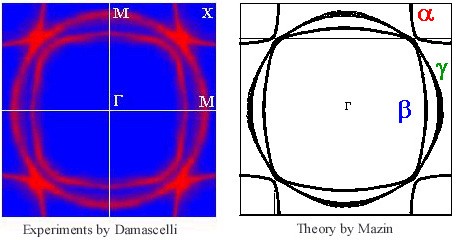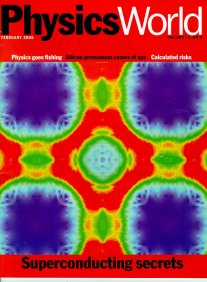 With the development of the latest generation of ultra-high resolution electron spectrometers in the past few years, the technique of angle resolved photoemission spectroscopy (ARPES) has recently experienced a renaissance. Nowhere is this revolution more evident than in the study of the high-temperature superconductors, which more than a decade after their discovery, continue to defy theoretical explanation. Recent ARPES experiments performed at Beam Line 5-4 have led to critical new discoveries about the fundamental nature of these mysterious superconductors and are now changing the way that the physics community views these materials. An excellent benchmark for the huge leap in detector resolution and technology is the recent work on Sr2RuO4. Although it belongs to a slightly different family than the high- temperature superconductors, its exotic superconducting mechanism (Tc= 1K) and complex electronic structure make it itself a fascinating material. In the past, due to poor resolutions, ARPES studies on this material were in disagreement with theory and other experimental techniques. However, with the use of the new spectrometer on Beam Line 5-4, this longstanding controversy has finally been resolved by studying the electronic states as a function of momentum and energy with unprecedented details [1]. As a result, the subtle issues that plagued the earlier studies have been clarified, demonstrating both the reliability and unique sensitivity of ARPES as a technique for studying complex materials.
With the development of the latest generation of ultra-high resolution electron spectrometers in the past few years, the technique of angle resolved photoemission spectroscopy (ARPES) has recently experienced a renaissance. Nowhere is this revolution more evident than in the study of the high-temperature superconductors, which more than a decade after their discovery, continue to defy theoretical explanation. Recent ARPES experiments performed at Beam Line 5-4 have led to critical new discoveries about the fundamental nature of these mysterious superconductors and are now changing the way that the physics community views these materials. An excellent benchmark for the huge leap in detector resolution and technology is the recent work on Sr2RuO4. Although it belongs to a slightly different family than the high- temperature superconductors, its exotic superconducting mechanism (Tc= 1K) and complex electronic structure make it itself a fascinating material. In the past, due to poor resolutions, ARPES studies on this material were in disagreement with theory and other experimental techniques. However, with the use of the new spectrometer on Beam Line 5-4, this longstanding controversy has finally been resolved by studying the electronic states as a function of momentum and energy with unprecedented details [1]. As a result, the subtle issues that plagued the earlier studies have been clarified, demonstrating both the reliability and unique sensitivity of ARPES as a technique for studying complex materials.
Moving to the high-temperature superconductors, a recent article published in Science by D.L. Feng et al., on the compound Bi2Sr2CaCu2O8+δ, has shown that the photoemission spectra exhibits unexpected sensitivity to the superconductivity [2]. In particular, the intensity of the (p,0) peak in the photoemission spectrum exhibits striking resemblance to the density of paired electrons participating in the superconducting state, as measured by other techniques. This surprising manifestation of collective quantum effects in single-particle excitation spectrum may indicate that the pairing of electrons in the superconducting state cannot be reconciled with more conventional theories, but rather, point to more exotic pairing mechanisms.
Although is, Bi2Sr2CaCu2O8+δ by far, the most studied superconductor by ARPES, a long-standing mystery has been the absence of so-called bilayer splitting in the electronic structure. It has been theoretically predicted that the interaction between the two adjacent CuO2 layers in Bi2Sr2CaCu2O8+δ would result in a doubling in the number of bands. However, such a splitting has never been observed in previous ARPES studies, and hence deemed nonexistent and unimportant. Recent experimental confirmation of this long-sought bilayer splitting by D.L. Feng et al. in Physical Review Letters[3] unambiguously demonstrated that the interaction between neighboring CuO2 planes strongly affects the electronic structure, and that theories must be once again revisited to include the bilayer interaction in any accurate description of Bi2Sr2CaCu2O8+δ.
YBa2Cu3O7-δ is one of the most extensively studied high temperature superconductors not only because it is one of the first true "high" Tc superconductors, but also due to its enormous application potential. All previous photoemission experiments on this material had been plagued by unfortunate surface effects which have obfuscated the measurements. Recently, there was a breakthrough in this challenging problem, made possible by significantly improved sample quality and instrumental resolutions. The article in Physical Review Letters by D.H. Lu et al. [4] reports the first observation of the so called "peak-dip-hump" structure on a system other than Bi2Sr2CaCu2O8+δ, finding key similarities in the spectra from YBa2Cu3O7-d and the more well-understood Bi2Sr2CaCu2O8+δ, as well as some notable differences which may arise from their slightly different crystal structures.
 From YBa2Cu3O7-δ, the most popular, we move to Nd2-xCexCuO4, the "black sheep" in the family of high-temperature superconductors. Because the doped charge carriers in Nd2-xCexCuO4 are electrons, as opposed to holes for YBa2Cu3O7-δ, Bi2Sr2CaCu2O8+δ, and the vast majority of high-Tc's, the properties of Nd2-xCexCuO4 are significantly different from its hole-doped cousins. This disparity, along with the dearth of experimental data, has made the few electron-doped high-Tc superconductors rather poorly understood. In particular, while it is now widely accepted that the superconducting pairing in the hole-doped materials is strongly dependent on the momentum of the electrons (a d-wave symmetry), it has been long believed that the pairing in the electron-doped materials had no such momentum dependence (ans-wave symmetry). However, new photoemission data from N.P. Armitage et al., published in Physical Review Letters [5], has challenged that long-standing notion by detecting a small but clear momentum asymmetry by utilizing the extremely high energy resolution of the new electron spectrometer on Beam Line 5-4. The detection of this momentum dependence in the superconducting pairing demonstrates that the electron and hole doped materials may not be as disparate as originally believed, moving us closer towards a unified picture of the high-temperature superconductors. Some of the work on Nd2-xCexCuO4 appeared on the cover page of February 2000 issue of Physics World.
From YBa2Cu3O7-δ, the most popular, we move to Nd2-xCexCuO4, the "black sheep" in the family of high-temperature superconductors. Because the doped charge carriers in Nd2-xCexCuO4 are electrons, as opposed to holes for YBa2Cu3O7-δ, Bi2Sr2CaCu2O8+δ, and the vast majority of high-Tc's, the properties of Nd2-xCexCuO4 are significantly different from its hole-doped cousins. This disparity, along with the dearth of experimental data, has made the few electron-doped high-Tc superconductors rather poorly understood. In particular, while it is now widely accepted that the superconducting pairing in the hole-doped materials is strongly dependent on the momentum of the electrons (a d-wave symmetry), it has been long believed that the pairing in the electron-doped materials had no such momentum dependence (ans-wave symmetry). However, new photoemission data from N.P. Armitage et al., published in Physical Review Letters [5], has challenged that long-standing notion by detecting a small but clear momentum asymmetry by utilizing the extremely high energy resolution of the new electron spectrometer on Beam Line 5-4. The detection of this momentum dependence in the superconducting pairing demonstrates that the electron and hole doped materials may not be as disparate as originally believed, moving us closer towards a unified picture of the high-temperature superconductors. Some of the work on Nd2-xCexCuO4 appeared on the cover page of February 2000 issue of Physics World.
Collaboration with a group at University of Tokyo in Japan produced an important result in a more fundamental problem. Spin-charge separation is an exotic phenomenon in which the charge and spin of an electron are separated and behave like independent particles. This phenomenon occurs only in one dimensional (1D) systems and was first confirmed by an experiment in insulating SrCuO2, performed at SSRL. Observation of such phenomenon in a metallic system would be important and there have been steady efforts to observe spin-charge separation in metallic 1D systems. These efforts, however, have been hindered by materials issues. PrBa2Cu3O7 is one of the rare systems that provide possibility of studying doped Cu-O chains. The work by T. Mizokawa et al. reported in Physical Review Letters [6] shows two dispersive features, corresponding to the spinon and holon edges. It is the first convincing experimental evidence of spin-charge separation in a doped Cu-O chain.
- A. Damascelli et al., Physical Review Letters, vol. 85, no. 24, p. 5194 (2000).
- D.L.Feng et al., Science, vol.289, no. 5477, p. 277 (2000).
- D.L. Feng et al., Physical Review Letters, vol. 86, p. 5550 (2001).
- D.H. Lu et al., Physical Review Letters, vol. 86, p. 4370 (2001).
- N.P. Armitage et al., Physical Review Letters, vol. 86, no. 6, p. 1126 (2001).
- T. Mizokawa et al., Physical Review Letters, vol. 85, no. 22, p. 4779 (2000).




